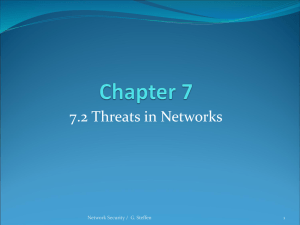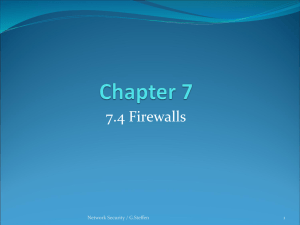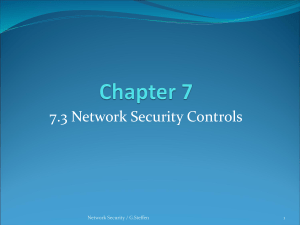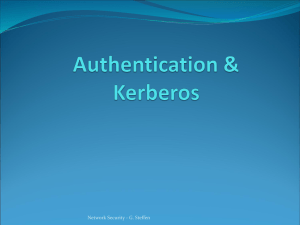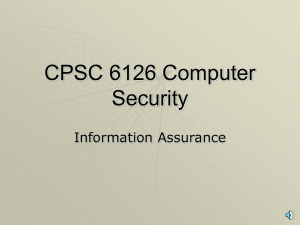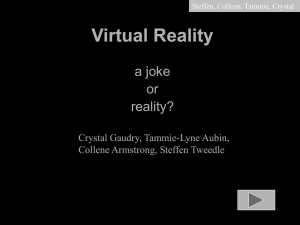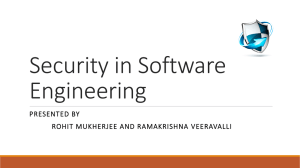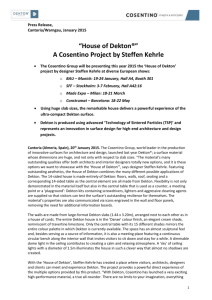Chapter 1
advertisement
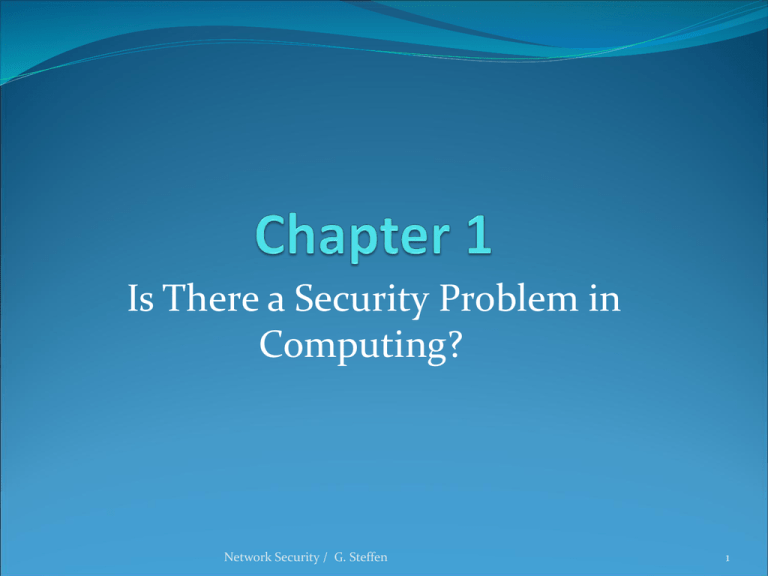
Is There a Security Problem in Computing? Network Security / G. Steffen 1 In This Chapter The risks involved in computing The goal of secure computing: confidentiality, integrity, availability The threats to security in computing: interception, interruption, modifications, fabrication Controls available to address these threats: encryption, programming controls, operating systems, network controls, administrative controls, laws and ethics Network Security / G. Steffen 2 What Does “Secure” Mean? Are you Secure? What makes you feel secure? Example: Banks Yesterday – learning from the past Today Protecting Valuables Protecting Money Vs. Protecting Information Size and Portability (large vs. small) Ability to Avoid Physical Contact (lots vs. little) Value of Asset (very high vs. variable) Network Security / G. Steffen 3 Developing an Understanding Examine the risk of security in computing Consider available countermeasures or controls Stimulate thought about uncovered vulnerabilities Identify areas where more work is needed Network Security / G. Steffen 4 Characteristics of Computer Intrusion Any computer system can be a target: Hardware, Software, Storage, Data, People/User Any system is most vulnerable at its weakest point. Principle of Easiest Penetration - An intruder must be expected to use any available means of penetration. Penetration may not necessarily be by the most obvious means, nor via the one we have the most defense against. Consider all the means of penetration Checked repeated times Don’t underestimate the attacker/think like an attacker Strengthening one thin might weaken another Network Security / G. Steffen 5 Attacks The components to attack: Hardware Software Data Vulnerability – a weakness in the security system that could be exploited to cause harm or loss. Threat – a set of circumstances that has the potential to cause loss or harm. Wall holding back water Threat to get wet Vulnerability is a crack in the wall Network Security / G. Steffen 6 Network Security / G. Steffen 7 Attack – human who exploits a vulnerability Control – a protective measure against an attack A threat is blocked by control of vulnerability Type of System Security Threats in computing Interception Interruption Modification Fabrication Network Security / G. Steffen 8 Network Security / G. Steffen 9 Method, Opportunity & Motive Why? Who? What? When? Where? Attacker must have three things: Method – the skill, knowledge and tool Opportunity – the time and access Motive – a reason to want to perform an attack Network Security / G. Steffen 10 Security Goals Secure is: Confidentiality (Secrecy or Privacy)- assets accessed only by authorized parties Not only reading but viewing, printing or knowing about the asset Integrity – assets modified only by authorized parties Includes writing, changing, changing the status, deleting or creating Availability – assets are accessible to authorized parties at appropriate times. Denial of Service Network Security / G. Steffen 11 Network Security / G. Steffen 12 Vulnerabilities Hardware It is very visible Easy to attack Water, burned, frozen, gassed and electrocuted, dust, time, rodents, environment Voluntary Machine Slaughter or Machinicide Software Software Deletion Software Modification Software Theft Network Security / G. Steffen 13 Network Security / G. Steffen 14 Malicious Modification of Software Logic Bomb Trojan Horse Virus Trapdoor Information leaks Data Vulnerabilities Effects everyone Data is more than just an electronic file Principle of Adequate Protection – Computer items must be protected only until they lose their value. Data Confidentiality Data Integrity Other Exposed Assets Networks Access Key People Network Security / G. Steffen 15 Network Security / G. Steffen 16 Computer Criminals Amateurs Crackers or Hackers Career Criminal Terrorists Network Security / G. Steffen 17 Methods of Defense Harm occurs when a threat is realized against a vulnerability Risk – the possibility of harm Dealing with Harm Prevent it Deter it, Deflect it, Detect it, And Recover from it. Network Security / G. Steffen 18 Controls Control – attempt to prevent the exploitation of a vulnerability Computer Security has lots of controls Simple or Difficulty Inexpensive or Expensive Type of Control Encryption – formal name for the scrambling process deals with confidentially and integrity Does not solve computer security problems. Cleartext Ciphertext Protocols Network Security / G. Steffen 19 Software Controls Programs must be secure to prevent attacks Program Controls: Internal Program Controls Operating System and Network System Controls Independent Control Programs (virus checker) Development Controls (quality standards in construction) Software controls effect the user Hardware Controls Smart cards, locks, devices to ID users, firewalls, intrusion detection systems, circuitry control Policies and Procedures Policies – an agreement of way things are done Must be written and training provided Physical Controls – locks/security officer/backups Network Security / G. Steffen 20 Effectiveness of Controls Controls must be properly used! Awareness of Problem Likelihood of Use Principles of Effectiveness - Control must be usedand used properly- to be effective. They must be efficient, easy to use, and appropriate. Overlapping Controls (good) Periodic Review – controls are not permanent Principle of Weakest Link – Security can be no stronger than its weakest link. Network Security / G. Steffen 21 Conclusion The risks involved in computing The goal of secure computing: confidentiality, integrity, availability The threats to security in computing: interception, interruption, modifications, fabrication Controls available to address these threats: encryption, programming controls, operating systems, network controls, administrative controls, laws and ethics Network Security / G. Steffen 22
